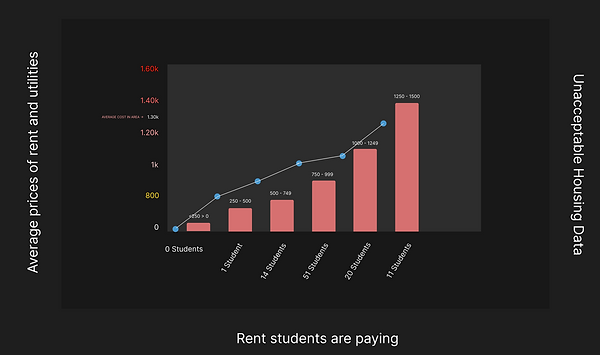
Bryce Li
Student Housing Costs: Comparing Rent, Utilities, and Unacceptable Housing Data
By Nish Verma, Bryce Li, Lily He, Jiating Zhang
Time: July, 2024
Software: Mapbox, Illustrator
Role: Designer
Introduction
In order to address the specific financial and living issues that Waterloo students majoring in Global Business and Digital Arts face, it is imperative to comprehend the housing landscape. In-depth research is done on the rent and utility expenses that GBDA students currently pay. Average costs from the 2021 census are compared, and housing suitability is evaluated. We hope to provide insight into whether GBDA students are receiving a fair
deal for their housing costs by mapping out student houses and assessing how close they are to the university and other important facilities. The analysis also emphasizes how much more expensive GBDA students had to pay than the typical Waterloo resident, which raises serious concerns regarding the availability and affordability of student housing in the area for this particular population.
Data Analysis
Three datasets are used in the examination of housing for GBDA students in Waterloo. First, according to data on student housing, GBDA students are primarily located in neighbourhoods like Lester, Phillip, and Columbia Street West. Second, while the average rent in these places is roughly $1,300, the data from the 2021 census on rent and utilities reveals that the majority of GBDA students pay between $750 and $999, indicating their attempts to find more cheap accommodation despite their lower income. Adding on, the unsatisfactory housing data shows that regions with higher rents frequently have worse living conditions. The average Waterloo resident makes about $4,416.67 / month. If subtracted by 900 (a number used for average rent) in this case, only 20.38% of their salary went to rent. While a student, who earns roughly $1,750 / month uses 51.48% of their monthly salary towards rent, which is a little more than half their pay. Overall, although though GBDA students are able to obtain somewhat better living conditions in their priority areas, they nevertheless experience severe financial hardship since, in comparison to normal residents, they spend a large amount of their salary on rent.
Visuals

With over 72,400 full-time post-secondary students, the Waterloo Region puts a lot of strain on the local housing market, which raises demand for reasonably priced homes. According to recent data, the cost of accommodation has significantly increased; students now pay between $750 and $1,200 a month for internet, electricity, and rent, up from $595 in 2016. According to The Record in 2024, this increase is made worse by inflation and a lack of beds, which is leading to a surge in student homelessness. Students still struggle with affordability even though a large number of them live in low-rent neighbourhoods; in high-rent areas, up to 40% of housing is considered unsatisfactory. Due to financial situations, students are forced to work longer hours, which has an effect on both their mental and academic well-being. Our recommendations to address these problems include expanding the availability of affordable housing, improving rental assistance programs, and enforcing more stringent housing regulations to improve student affordability and living conditions.

Key Takeaways
Students in Waterloo are facing substantial financial strain, with monthly accommodation rates ranging from $750 to $1,200, up from $595 in 2016. Many people spend more than half of their salary on housing, resulting in affordability concerns and bad living conditions, with up to 40% of high-rent homes considered unsatisfactory. This financial strain drives students to work longer hours, which has an impact on their academic performance and mental health. Student homelessness has also increased due to rising housing expenses and a shortage of beds. To solve these pressing issues, policy reforms must be implemented immediately, such as expanding affordable housing options, improving rental assistance, and enforcing tighter housing standards.
References
8, I. (2022). Stop icon. Icons. https://icons8.com/icons/set/stop
8, I. (2023). Money bag icon. Icons. https://icons8.com/icons/set/money-bag
Con, I. (2022). Chart Icon. FlatIcon. https://www.flaticon.com/free-icon/chart_3446795?term=chart&page=1&position=18&origin=tag&related_id=3446795
Math, M. (2021a). Rent (and utilities). Census Mapper. https://censusmapper.ca/maps/3525
Math, M. (2021b). Unacceptable housing. Census Mapper. https://censusmapper.ca/maps/3515
Outhit, J. (2024a, April 16). Housing slump deepens as new home construction plunges in Waterloo Region. The Record. https://www.therecord.com/news/waterloo-region/housing-slump-deepens-as-new-home-construction-plunges-in-waterloo-region/article_c9f196b8-4daa-59e5-9ca5-07b7d1e113de.html
Outhit, J. (2024b, July 19). Waterloo region falling short in housing pledge. The Record. https://www.therecord.com/news/waterloo-region/waterloo-region-falling-short-in-housing-pledge/article_ab0dba24-abdf-5692-9360-7c3dbd51c505.html
Peng, Z. (2024, July 11). Housing Data. GBDA 303 A2 Stratford Housing Survey_Cleaned.xlsx. https://learn.uwaterloo.ca/content/enforced/1032246-GBDA303_jlthomps_z2peng_1245/GBDA 303 A2 Stratford Housing Survey_Cleaned.xlsx
Waterloo, R. (2020). Education and talent. Region of Waterloo. https://www.regionofwaterloo.ca/en/doing-business/education-and-talent.aspx